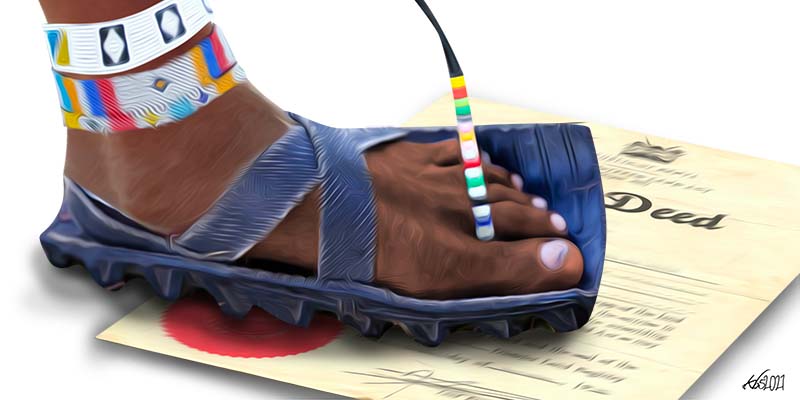In the name Parsaloi Ole Gilisho there lies an irony. It was spelled Legalishu by the colonial British. Say it out loud. He gave them a legal issue, all right. And a 110-year-old headache.
This extraordinary age-set spokesman (a traditional leader called ol-aiguenani, pl. il-aiguenak) led non-violent resistance to the British, in what was then British East Africa, that culminated in the Maasai Case 1913. Ole Gilisho was then a senior warrior, who was probably in his mid- to late thirties. In bringing the case before the High Court of British East Africa, he was not only challenging the British but also the Maasai elders who had signed away thousands of acres of community land via a 1904 Maasai Agreement or Treaty with the British. This and the 1911 Agreement – which effectively rendered the first void – are often wrongly called the Anglo-Maasai Agreements. In Ole Gilisho’s view, and those of his fellow plaintiffs, these elders had sold out. The suit accused them of having had no authority to make this decision on behalf of the community. This represented a very serious challenge by warriors to traditional authority, including that of the late laibon (prophet) Olonana, who had signed in 1904, and died in 1911.
The British had expected the Maasai to violently rebel in response to these issues and to colonial rule in general. But contrary to modern-day myths that the Maasai fought their colonisers, here they resisted peacefully via legal means. They hired British lawyers and took the British to their own cleaners. Spoiler: they lost, went to appeal, and lost again. But archival research reveals that the British government was so convinced it would eventually lose, if the Maasai appealed to the Privy Council in London (they didn’t), that officials began discussing how much compensation to pay.
The facts are these. The lawsuit was launched in 1912. There were four plaintiffs, Ole Gilisho and three fellow Purko (one of the 16 Maasai territorial sections) Maasai. In Civil Case No. 91 they claimed that the 1911 Maasai Agreement was not binding on them and other Laikipia Maasai, that the 1904 Agreement remained in force, and they contested the legality of the second move. They demanded the return of Laikipia, and £5,000 in damages for loss of livestock during the second move (explained below). Ole Gilisho was illiterate and had never been to school. But he and his fellow plaintiffs were assisted by sympathetic Europeans who were angered by the injustice they saw being perpetrated against a “tribe” that British administrators conceded had never given them any trouble. These sympathisers included people who worked for the colonial government, notably medical Dr Norman Leys and some district officials, lawyers, a few missionaries, the odd settler, and a wider group of left-wing MPs and anti-colonial agitators in Britain.
What had led up to this? After the 1904 Agreement, certain groups or sections of Maasai had been forcibly moved from their grazing grounds in the central Rift Valley around Naivasha into two reserves – one in Laikipia, the other in the south on the border with German East Africa. The British had pledged that this arrangement was permanent, that it would last “so long as the Maasai as a race shall exist”. But just seven years later, the British went back on their word and moved the “northern” Maasai again, forcing them at gunpoint to vacate Laikipia and move to the Southern Reserve. In all, it is estimated that the Maasai lost at least 50 per cent of their land, but that figure could be nearer 70 per cent. The ostensible reason for moving them was to “free up” land for white settlement – largely for British settlers but also for South Africans fleeing the Boer War (also called the South African War).
But just seven years later, the British went back on their word and moved the ‘northern’ Maasai again, forcing them at gunpoint to vacate Laikipia and move to the Southern Reserve.
By the time the case came to court, Ole Gilisho had become a defendant, even though he was in favour of the plaint. So were at least eight other defendants. He had signed the 1904 Agreement, and now stood accused with 17 other Maasai of having no authority to enter into such a contract. The first defendant was the Attorney General. Ole Gilisho’s son-in-law Murket Ole Nchoko, misspelled Ol le Njogo by the British, and described as a leading moran (il-murran or warrior) of the Purko section, was now the lead plaintiff. The plaint was called Ol le Njogo and others v. The Attorney General and others.
Challenges facing the plaintiffs
Most Maasai were illiterate in those days, and this obviously placed them at a major disadvantage. They could not write down their version of events. They were forced to rely, in their dealings with officials and their own lawyers, upon translators and semiliterate mediators whose reliability was questionable. But it is evident, from the archival record which includes verbatim accounts of meetings between Maasai leaders and British officials in the run-up to the moves and case, that the level of verbal discourse was highly sophisticated. This comes as no surprise; verbal debate is a cornerstone of Maasai society and customary justice. Unfortunately, that alone could not help them here. They knew they needed lawyers, and asked their friends for help. Leys, who was later sacked from the colonial service for his activism, admitted in a private letter: “I procured the best one in the country for them.” This was more than he ever admitted openly.
Local administrators used intimidation and all kinds of devious means to try and stop the case. (I didn’t come across any evidence that the Colonial Office in London sanctioned this; in fact, it ordered the Governor not to obstruct the main lawyer or his clients.) They allegedly threatened Ole Gilisho with flogging and deportation. They threatened and cross-questioned suspected European sympathisers, including Leys and the lawyers. They banned Maasai from selling cattle to raise the legal fees, and placed the Southern Reserve in continuous quarantine. It was hard for the plaintiffs, confined to a reserve, to meet their lawyers at all. At one point, lawyers were refused passes to enter the reserve, and their clients were prevented from leaving it.
We hear Ole Gilisho’s voice in the archival record. Forced to give a statement explaining his actions to officials at Enderit River on 21 June 1912, when asked if he had called Europeans to his boma, he replied: “Is it possible for a black man to call a white man?” He denied having called the Europeans (probably lawyers or go-betweens), saying they had come to him. Leys later explained to a friend that Ole Gilisho had probably been “terrified out of his wits”, and hadn’t meant what he said.
What happened in court
The case was thrown out when it first came before the High Court in Mombasa in May 1913. The Maasai appealed, and that is when the legal arguments were fully aired by both sides – lawyers for the Crown and the Maasai. The appeal was dismissed in December on the grounds that the plaintiffs’ claims were not cognisable in municipal courts. The two agreements were ruled not to be agreements but treaties, which were Acts of State. They could not, therefore, be challenged in a local court. It was impossible for the plaintiffs to seek to enforce the provisions of a treaty, said the judges – “The paramount chief himself could not bring such an action, still less can his people”. Claims for damages were also dismissed.
The Court of Appeal’s judgement centred on the status of a protectorate, in which the King was said to exercise powers granted to him under the Foreign Jurisdiction Act of 1890. Irrational as it sounds, the Crown claimed that British East Africa was not British territory, and the Maasai were not British subjects with any rights of access to British law, but “protected foreigners, who, in return for that protection, owe obedience” to the Crown. As Yash Pal Ghai and Patrick McAuslan later put it, when discussing the case in a 1970 book: “A British protected person is protected against everyone except the British.” On the plus side, the judges ruled that the Maasai still retained some “vestige” of sovereignty. (The Maasai’s lawyer argued that they did not.) This triggered later moves by Maasai politicians, in the 1960s, to float the idea of secession from Kenya and the possible creation of a sovereign Maasai state. John Keen had threatened this in 1962 at the second Lancaster House Conference in London, attended by a Maasai delegation.
Alexander Morrison, lawyer for the Maasai, argued that British rule and courts were established in the protectorate, which had not been the case 30 years earlier. The Maasai were not foreigners but equal to other British subjects in every way. The agreements were civil contracts, enforceable in the courts, and not unenforceable treaties. If one took the Crown’s claim about Acts of State to its logical conclusion, he argued, a squatter refusing to leave land reserved for the Maasai could only be removed by an Act of State. None of his arguments washed with the judges. (See my 2006 book Moving the Maasai for a fuller account.)
Morrison advised his clients to appeal. It seems they couldn’t raise the funds. However, oral testimony from elders reveals a different story: Ole Gilisho had planned to sail to England to appeal to the Privy Council, but he was threatened with drowning at sea. This is impossible to verify, but it rings true.
In an interview carried out on my behalf in 2008 by Michael Tiampati, my old friend John Keen had this to say about the outcome of the case: “If the hyena was the magistrate and the accused was a goat, you should probably know that the goat would not get any form of justice. So this is exactly how it was that the Maasai could not get any fair justice from British courts.”
Contemporary African resistance
Unbeknown to the Maasai, there was growing anti-colonial resistance in the same period in other parts of Africa. All these acts of resistance have inspired African activists in their continuing struggles. To mention a few: the Chilembwe rebellion in Nyasaland, now Malawi (1915); the Herero revolt in German South West Africa, now Namibia (1904–1908); resistance in present-day Kenya by Mekatilili wa Menza (largely 1913-14); the First Chimurenga or First War of Independence in what is now Zimbabwe (1896–1897); and the Maji Maji rebellion in German East Africa, now Tanzania (1905–1907). But none of these rebellions involved lawsuits. The closest precedent may have been R vs Earl of Crewe, Ex-parte Sekgoma in 1910. Chief Sekgoma, who had been jailed by the British in the Bechuanaland Protectorate (now Botswana) after many attempts to remove him as chief, instructed his lawyer to bring a writ of habeus corpus against the Secretary of State for the Colonies, Lord Crewe. He demanded to be tried in an English court, refusing an offer of release on condition that he agrees to live in a restricted area of the Transvaal. The suit was dismissed, the court ruling that the King had unfettered jurisdiction in a protectorate, and his right to detain Sekgoma was upheld. Sekgoma apparently said: “I would rather be killed than go to the Transvaal. I will not go because I have committed no crime – I wish to have my case tried before the courts in England or else be killed.” Freed in 1912, he died two years later.
Enduring myths
The case, and other key events in early twentieth century Maasai history, have given rise to several myths. They include the idea that the stolen land should “revert” to the Maasai after 100 years, but that was not stated in the 1904 Agreement, which was not limited in time, was not a land lease, and has not “expired” as many people claim. Neither agreement has. Keen knew this, but nonetheless called for the land to “revert”. Other myths include the idea that Olonana’s thumbprint was placed on the 1911 Agreement posthumously, and it must therefore be invalid. But neither his thumbprint nor name are on the document, which was “signed” by his son Seggi. Anyhow, Olonana was a key ally of the British, who had no reason to kill him (which is another myth).
The original of the 1904 Agreement has never been found, which has led some Maasai to believe that it never existed and therefore all the land must be restored and compensation paid for its use to date. There may be sound legal arguments for restorative justice, but this is not one of them. These myths are ahistorical and unhelpful, but may be understood as attempts to rationalise and make sense of what happened. Some activists may wish that the Maasai had resisted violently, rather than taken the legal route. Hence the insistence by some that there was a seamless history of armed resistance from the start of colonial rule. Not true. There are much better arguments to be made, by professional lawyers with an understanding of international treaty rights and aboriginal title, which could possibly produce results.
Ole Gilisho had planned to sail to England to appeal to the Privy Council, but he was threatened with drowning at sea.
Where does all this leave the Maasai today? Over the years, there has been much talk of revisiting the case and bringing a claim against Britain (or Kenya) for the return of land or reparations for its loss. None of this has resulted in concrete action. I attended a planning workshop in Nairobi in 2006 when plans were laid for a lawsuit. VIPs present included the late Ole Ntimama, scholar Ben Kantai and John Keen. Keen declared, with his customary flourish, that he would stump up a million shillings to get the ball rolling. I don’t know how much money was raised in total, but it disappeared into thin air. As did the lawyers.
Leading lawyers have advised that too much time has passed, and (unlike the successful Mau Mau veterans’ suit) there are no living witnesses who could give evidence in court. It is unclear whether the agreements still have any legal validity. The British government might argue, as it previously has, including in response to my questions, that it handed over all responsibility for its pre-1963 actions to the Kenyan government at independence. This is a ludicrous argument, which is also morally wrong. Former colonial powers such as Germany have accepted responsibility for historical injustices in their former colonies, notably Namibia. Has the time come for Ole Gilisho’s descendants to call a white man to court?








